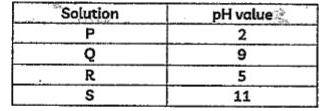Which of the following correctly represents the given substances in increasing order of kinetic energy of their particles?
Brick, water, air, honey
Honey, water, air, brick
Air, water, honey, brick
Brick, honey, water, air
The correct Answer is:D
To determine the increasing order of kinetic energy of particles in different substances, we need to understand how the state of matter affects the movement of particles and, consequently, their kinetic energy.
1. Understand the States of Matter:
- Solid: In solids, particles are closely packed together and can only vibrate in place. This limited movement results in the lowest kinetic energy.
- Liquid: In liquids, particles are less tightly packed than in solids and can move around each other. This allows for greater kinetic energy compared to solids.
- Gas: In gases, particles are far apart and move freely. This unrestricted movement results in the highest kinetic energy among the three states of matter.
2. Analyze the Given Substances:
- Brick: A solid, so it has the least kinetic energy.
- Honey: A dense liquid, which has more kinetic energy than a solid but less than water or air.
- Water: A less dense liquid than honey, allowing for more movement and therefore more kinetic energy than honey.
- Air: A gas, which has the most kinetic energy due to the high speed and freedom of movement of its particles.
3. Arrange in Increasing Order of Kinetic Energy:
- Start with the substance with the least kinetic energy and move to the one with the most:
- Brick (solid) < Honey (liquid) < Water (liquid) < Air (gas)
4. Final Answer:
- The correct increasing order of kinetic energy of the particles in the given substances is:
- Brick < Honey < Water < Air
- Solid: In solids, particles are closely packed together and can only vibrate in place. This limited movement results in the lowest kinetic energy.
- Liquid: In liquids, particles are less tightly packed than in solids and can move around each other. This allows for greater kinetic energy compared to solids.
- Gas: In gases, particles are far apart and move freely. This unrestricted movement results in the highest kinetic energy among the three states of matter.
- Brick: A solid, so it has the least kinetic energy.
- Honey: A dense liquid, which has more kinetic energy than a solid but less than water or air.
- Water: A less dense liquid than honey, allowing for more movement and therefore more kinetic energy than honey.
- Air: A gas, which has the most kinetic energy due to the high speed and freedom of movement of its particles.
- Start with the substance with the least kinetic energy and move to the one with the most:
- Brick (solid) < Honey (liquid) < Water (liquid) < Air (gas)
- The correct increasing order of kinetic energy of the particles in the given substances is:
- Brick < Honey < Water < Air
Topper's Solved these Questions
- MATTER IN OUR SURROUNDINGSBook:SCIENCE OLYMPIAD FOUNDATION Chapter:MATTER IN OUR SURROUNDINGSExercise:ARCHIEVERS SECTION (HOTS)
Explore 5 Videos
- IS MATTER AROUND US PURE Book:SCIENCE OLYMPIAD FOUNDATION Chapter:IS MATTER AROUND US PURE Exercise:MULTIPLE CHOICE QUESTION
Explore 20 Videos
- NSO QUESTION PAPER 2016 SET A Book:SCIENCE OLYMPIAD FOUNDATION Chapter:NSO QUESTION PAPER 2016 SET A Exercise:ACHIEVERS SECTION
Explore 1 Video
Similar Questions
Knowledge Check
Which of the following is correctly ordered :
A−Oh>−NH2 (+M effect)B−SO3H>−NO2 (-M effect)C−F>−CN (-l effect)D−CN>−F (-l effect)Which of the following correctly represents the type of fruits given
 A1. Berry , 2. Caryopsis , 3. Drupe , 4. Sorosis , 5. AggregateB2. Berry , 3. Caryopsis , 4. Drupe , 1. Sorosis , 5. AggregateC2. Berry , 3. Caryopsis , 4. Drupe , 5. Legume , 1. AggregateD2. Berry , 3. Caryopsis , 4. Drupe , 1. Sorosis , 5. Legume
A1. Berry , 2. Caryopsis , 3. Drupe , 4. Sorosis , 5. AggregateB2. Berry , 3. Caryopsis , 4. Drupe , 1. Sorosis , 5. AggregateC2. Berry , 3. Caryopsis , 4. Drupe , 5. Legume , 1. AggregateD2. Berry , 3. Caryopsis , 4. Drupe , 1. Sorosis , 5. LegumeWhich of the following correctly represents the order of atomic radii
AMg2+<Na+<F≺O2−BNa+<F≺Mg2+<O2−CNa+<Mg2+<O2−<F−DO2−<F≺Na+<Mg2+
Which of the following reactions is correctly represented?
View SolutionThe table probides the pH value of four solutions P, Q, R and s

Which of the following correctly represents the solutions in increasing order of their hydronium ion concentration ?
View SolutionWhich of the following correctly represents the increasing order of densities IA group elements?
View SolutionWhich of the following correctly represent the acidic strenth of given acids?
View SolutionWhich of the following reactions is correctly represented?
View Solution

